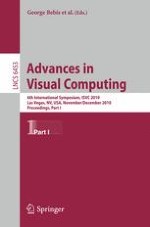It is with great pleasure that we present the proceedings of the 6th Inter- tional, Symposium on Visual Computing (ISVC 2010), which was held in Las Vegas, Nevada. ISVC provides a common umbrella for the four main areas of visual computing including vision, graphics, visualization, and virtual reality. The goal is to provide a forum for researchers, scientists, engineers, and pr- titioners throughout the world to present their latest research ?ndings, ideas, developments, and applications in the broader area of visual computing. This year, the program consisted of 14 oral sessions, one poster session, 7 special tracks, and 6 keynote presentations. The response to the call for papers was very good; we received over 300 submissions for the main symposium from which we accepted 93 papers for oral presentation and 73 papers for poster p- sentation. Special track papers were solicited separately through the Organizing and Program Committees of each track. A total of 44 papers were accepted for oral presentation and 6 papers for poster presentation in the special tracks.
